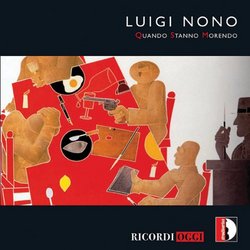| All Artists: Luigi Nono, Roberto Cecconi, Ingrid Ade-Jesemann, Monika Bair-Ivenz, Monika Brustman Title: Luigi Nono: Quando Stanno Morendo Members Wishing: 0 Total Copies: 0 Label: Stradivarius Original Release Date: 1/1/2008 Re-Release Date: 5/13/2008 Genres: Pop, Classical Styles: Vocal Pop, Chamber Music, Historical Periods, Classical (c.1770-1830) Number of Discs: 1 SwapaCD Credits: 1 UPCs: 8001575700793, 8011570570079 |
Search - Luigi Nono, Roberto Cecconi, Ingrid Ade-Jesemann :: Luigi Nono: Quando Stanno Morendo
 | Luigi Nono, Roberto Cecconi, Ingrid Ade-Jesemann Luigi Nono: Quando Stanno Morendo Genres: Pop, Classical
|
Larger Image |
CD Details |
CD ReviewsSeminal Nono, what he does best. . . scarecrow | Chicago, Illinois United States | 07/15/2008 (5 out of 5 stars) "Written in 1985 in Baden-Baden; Quando stanno morendo #2 is for four female voices, flute, cello and live electronics. It was written for the Warsaw Music Festival of that year: the festival however never happened, friends of Nono were hiding in exile, were in prison or resisting the so-called Russian invasion that never happened; the first section, reveals a pointillism, slow for Nono had a way of gleaning/bundling anxiety and beauty simultaneously from the most barren horror-struck vocal intervals;then longer tones a capella and sustained winds - There are two sections with three poems . "My faithful tongue, I have served you ... you have been my only home because I lost the other ... because the thistle has covered its land" (Czeslaw Milosz) begins the first section, then amplified basso, penumbral cello strings begin the second section - "Moscow - who are you? Moscow - ancient skull with a blade of stone ... you are orthodox wolves ..." (Velemir Chlebnikov).
Nono thes last ten years, 1980-1990 had worked with particles of timbre, on various ways of utilizing the breath with various similar tones;for FLute and Clarinet,dozens of tones were identified; later, Contrabass Flute, and Contrabass Clarinet were engaged for this work; amplified flute here come to resemble(unintendedly) trains, or horses, gentle breath harmonic sounds return, followed by solo voices accompanied by low electronic ringing sounds; the final chorus sings restrained agony of the beginning - "When they are dying, horses feel relief, when they are dying, shrubs become sad, when they are dying, suns cease to shine, when they are dying, men sing ..." (Velemir Chlebnikov). Similarly Nono had worked in Freiburg Electronic Studios with the Tuba Player-Trombonist Giancarlo Schiaffini,dedicating the "Post Prealudium per Donau" to him,this is like a sketch from this time the mid-Eighties. The Tuba player plays half-valved tones very high in treble places, multiphonics, (singing one tone into the instrument while playing,(( an eering chord out-of-tune results)), the live electronics propells all this sustaining in a cavernous-like reverb,very primitive sounding, part of his aesathetic at this time, to return to where one began;timbre,klangfarben; the technology back then was rather primitive for Nono, where multiple kinds of microphones and a cumbersome electronic configuration was required to produce the simplist results. The piece is in three sections,(A-B-C)and is about motion,movement, the slow transformations,transmogrifications of timbre the first, there are "pathways" "percorsi" written on the score in interesting red, yellow, blue and green pens, the performer while traversing four lines can break systems and go to another, following the the colours, much like one travels in exile, or in your own land occupied by another "Other", as in the Middle East today. The work is quite eeree and a seminal work for Tuba, the live electronics transforms the Tuba (playing into a microphone)simply into a passive sound producer,like its existence has been suspended and its beauty restrained, the registers exploited are either distorted ones, (half-valved tones, lipped out-of-tune microintervals, or multiphonics), then the final section resides on a loud bombastic Low C-natural,all sustained powerfully with the electronics;, there is also an interesting antiphonal set-up; Nono knew very well the means of structure through discreet compact shapes work; very powerful for a mere 14 minutes.Likewise the piece dedicated to Pierre Boulez, who really didn't approave of his work the latter years; Again pits incredible Contra-bass Flute and Contra-Bass Clarinet with small chorus. This CD is a reissue from recorded over ten years ago,but still the only recording of much of this music. " |

 Track Listings (3) - Disc #1
Track Listings (3) - Disc #1